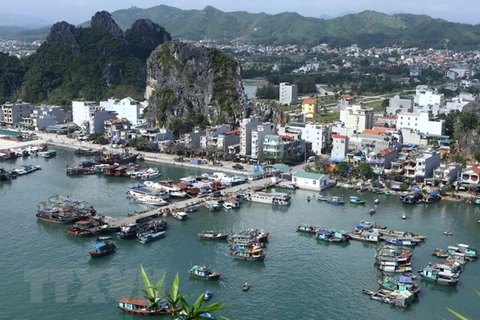Quang Ninh (VNA) – The northern coastal province of Quang Ninh is among leading localities in switching to green growth, with the goal of becoming an international tourism hub and a place worth of living by 2020.
Quang Ninh is the gateway for trade between Vietnam and the Association of Southeast Asian Nations (ASEAN) and China. Its advantages such as sea ports, border gates, tourism and coal mines which account for 90 percent of the country’s coal reserves have helped the province maintain a high economic growth rate. Local per capita income is 1.7 times higher than the national level, and the province is in the top five localities in terms of budget collection.
At the same time, those advantages themselves pose obstacles to the switch to a green growth model, such as the contradiction between mining and tourism development.
In addition, the province faces challenges from industrialisation and urbanisation, along with negative impacts of climate change.
Keeping its goal in sight, Quang Ninh has been carried out simultaneously three strategic priorities in order to create the foundation for green growth, which are infrastructure development, administrative reform and human resources improvement.
To create a breakthrough in infrastructure, the province has designed mechanisms and policies to mobilise resources from all sectors, especially non-State sector, for the construction of key infrastructure works such as essential roads, public facilities, and infrastructure in industrial parks and economic zones.
The province has taken drastic actions to build a growth-facilitating and service-oriented administration of integrity at all levels, complete institutions and reform administrative procedures from the provincial to communal levels.
For developing local human resources, Quang Ninh spent 11.2 billion VND in 2017 on training for local public officials and workers, and built a project on attracting and training manpower for industrial parks and economic zones in the locality during 2018-2020.
At the core of Quang Ninh’s shift to green growth is the no-smoke industry. The province is resolved to optimise its natural advantages for the sustainable development of tourism.
Since 2015, Quang Ninh has implemented a green growth project targeting Ha Long Bay, a UNESCO-recognised World Heritage site and a major tourism destination in the province, with the sponsorship of the Japan International Cooperation Agency (JICA).
Phase one of the project was carried out from October 2015 to September 2016, focusing on building a detailed plan and defining priorities of work.
The second phase began in November 2016 and will last three years, aiming to enhance provincial funding and financial mechanism for environmental management and green growth; promote incentive for energy saving and management; promote sustainable tourism, and raise water environment management capacity by controlling direct waste discharge into the bay.
The project’s management board, in coordination with JICA experts and working groups, has held more than 50 meetings, working sessions with local agencies, sectors and authorities, and 20 surveys in target localities.
In early September this year, the project organised a communication workshop in Ha Long city aiming to raise awareness about the Ha Long Bay Area Green Growth White Book 2017. The book was compiled by JICA experts and the Quang Ninh provincial People’s Committee to deliver messages, experience, initiatives and actions towards green growth to not only managerial officials but also tourists and local businesses and residents.
Besides Ha Long Bay, Quang Ninh, with a 250km long coast line, is home to numerous sea tourism sites, including Bai Tu Long Bay and National Park, the islands of Co To, Tra Co and Van Don, to name just a few.
The province also boasts more than 600 cultural sites and historical relics, making it a popular destination for cultural and spiritual tourism. Some of the most well-known attractions are the Yen Tu landscape and historical site, the Bach Dang historical site and the Tran Dynasty cultural and historical site.
Last year, Quang Ninh received 9.87 million tourists, including 4.28 million foreigners, up 18 percent and 23 percent respectively. The tourism sector pocketed over 17.88 trillion VND (786.9 million USD), up 30 percent compared to the previous year.
It welcomed 9.2 million tourists during the first eight months of this year, up 25 percent year-on-year. The number of international holidaymakers to the locality exceeded 3.2 million, a rise of 18 percent against the same period last year, and fulfilling 65 percent of the yearly target.
This year, the province aims to attract over 12 million visitors this year, including 5 million foreigners.
By 2020, Quang Ninh aims to welcome 15-16 million tourists, including 7 million foreigners, and rake in 30 trillion VND - 40 trillion VND (1.3 billion USD - 1.7 billion USD) in revenue.-VNA

























